This Virtual Geocache will bring you on a tour of the Glendalough Monastic site and to tell you a little about its history, myths legends and lore.
To claim a find you will need to answer five questions and take two photographs here with a clearly visible "Thumbs up" gesture/sign. This is the gesture you will need to make in your photographs with your thumb ....

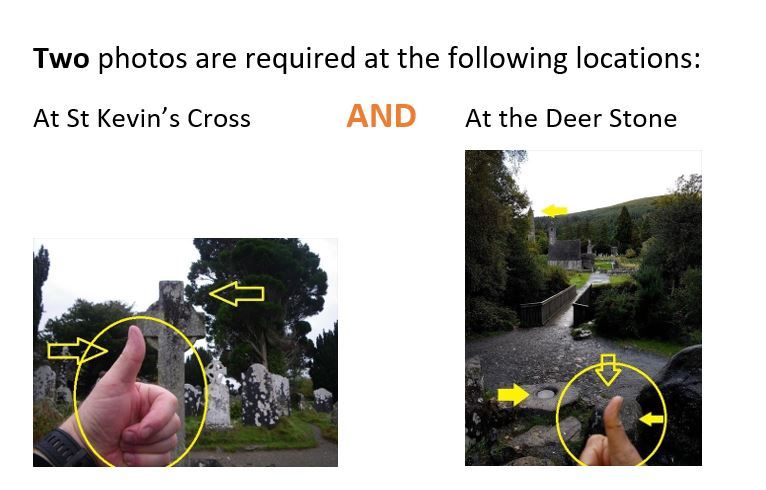
**The photo at the Deer Stone should
include the Bullan Stone, the bridge St. Kevin's Kitchen
and the Round Tower
in the background**
This is St Kevin's Cross Close up
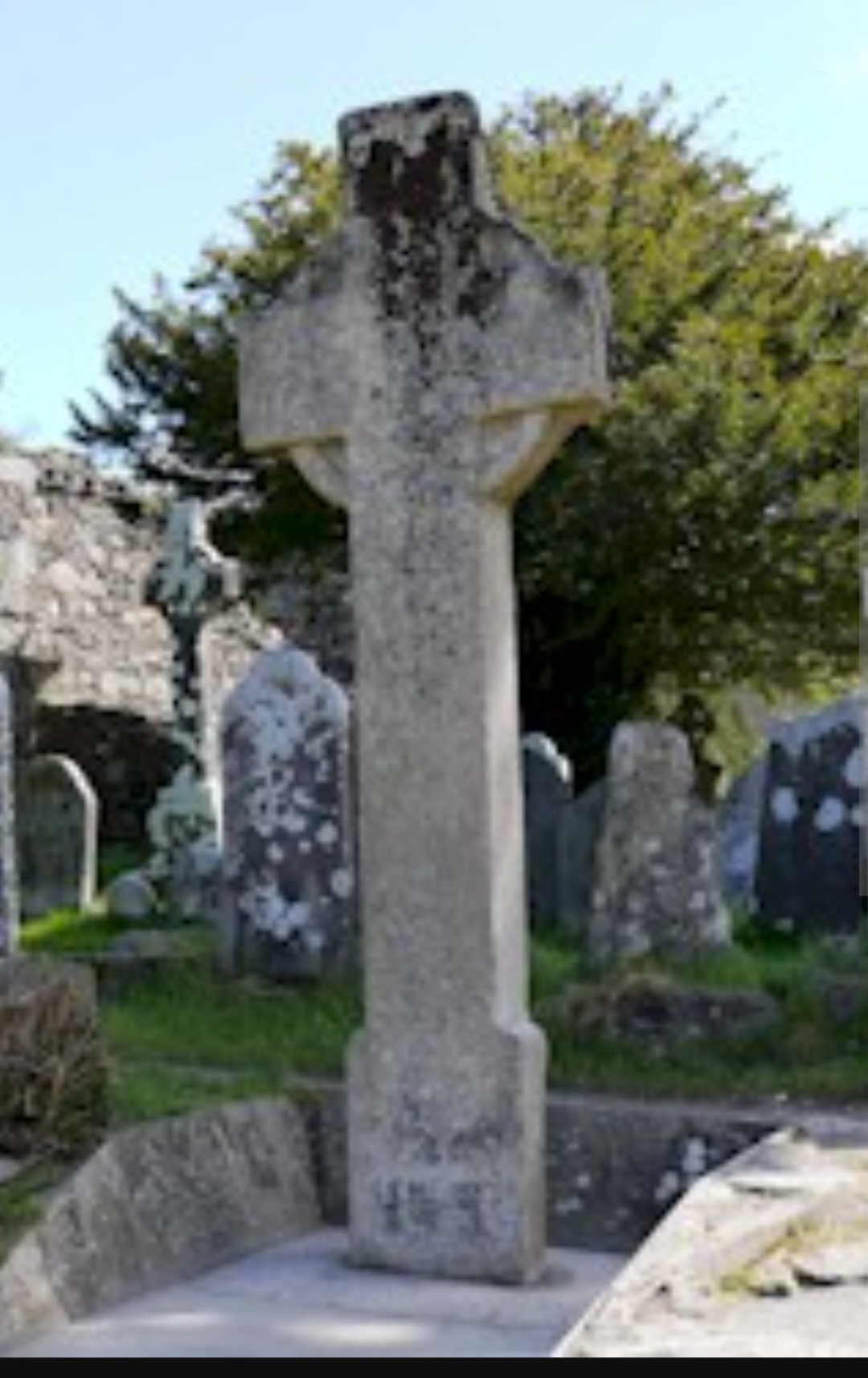
The name "Glendalough " means "the Glen of two lakes" in the Irish language. Glendalough is situated in the magnificent Wicklow Mountains National Park. The Glendalough Valley was carved during the ice age by glaciers. There you will find two magnificent lakes surrounded by cliffs and rocks, forests, waterfalls and unforgettable scenery. Visitors and pilgrims have been coming to Glendalough since early Celtic times, and today it is one of the most-visited ancient sites in Ireland.
Lonely Planet Ireland calls Glendalough
"Truly one of the most beautiful places in Ireland and a highlight of any trip to the island."
Here is a birds eye view for you to enjoy Arial Footage of Glendalough
Glendalough is one of the most important sites of monastic ruins in Ireland and is also known as the city of the seven Churches. It is steeped in history and archaeology with ancient tombs and cairns. The recorded history of the wooded valley dates from the 6th century - the dawn of Christianity in Ireland. For 500 years it was one of Ireland's great ecclesiastical foundations and schools of learning.
St Kevin (d. 618/622AD) is reputed to have founded Glendalough in the late 6th or early 7th century as a place of retreat from the world. Glendalough has attracted pilgrims and visitors over many centuries for its hallowed surroundings, its traditions and its stunning scenery. A remarkable collection of ruined medieval churches is spread out over 3km along the valley
Stage 1:The Gateway of Glendalough
Welcome to the ancient Gateway of Glendalough. This is the only early medieval gateway preserved to this day in Ireland. Apart from this magnificent archway very little is left of the original defensive walls that surrounded the city. The arches were built with Roman style columns. Its stones were cut to fit and no mortar was used in the construction.
Originally the gateway was thought to have had two stories and a wooden roof. In the upper part of the gate, there may have been a guard who watched those approaching the city. Inside the gateway, in the west wall, is a sanctuary stone.
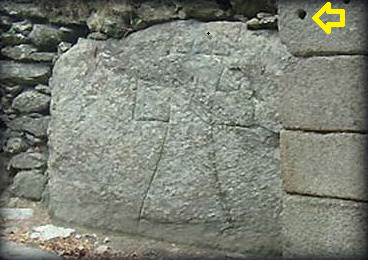
This slab has an unusual cross inscribed on it. Once anyone seeking sanctuary passed this marker they were given refuge within the monastic site.
Question 1. How many holes can you see in the archway at the gateway beside the sanctuary stone? There is an example in the image above. The answer is an even number.
Stage 2: The Round Tower
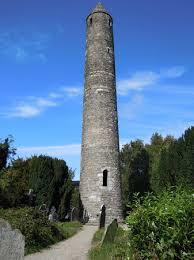
The Round Tower of Glendalough is considered one of the most beautiful in Ireland and is almost 1000 years old. This 30 meter tall tower is built of mica schist with a granite doorway. The conical roof was rebuilt in 1876 using stones found inside. The tower is divided internally into seven stories by timber floors, connected by ladders. In medieval Ireland, round towers served as landmarks to guide pilgrims from afar or as bell towers, storehouses, lookouts, and places of refuge in times of attack. The door is about 3.5 meters from the ground, which is commonly believed to be a defensive practice with refuge seekers raising the ladder from within.
Adjacent to the round tower stands a replica high cross which marks the grave of the great granddaughter of John and Alice Cowley. There are four decorative motifs on the arms of the cross, two of which were animals.
Question 2: What two animals are found on the left and right arms of the replica high cross?
Stage 3 The ‘Cathedral’ of St. Peter and St. Paul
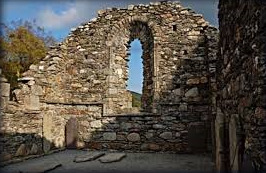
The 'Cathedral' is the largest of the seven churches in Glendalough. It was built in several phases from the 10th through the early 13th century. Large mica schist stones, which form the foundation up to the height of the west doorway, were re-used from an earlier smaller church. The earliest part is the nave with antae for supporting the wooden roof. The chancel, sacristy, and north door were added in the late 12th and early 13th centuries. The north doorway to the nave also dates from this period. Inside there is a wall cupboard, a stone font, many grave slabs, and the remains of a decorated arch.
Question 3: A number of gravestones are to be found positioned horizontally on the ground inside of the cathedral . The one you need to find is at the rear on the left hand side under the window/arch. The headstone is engraved with the names of Joseph and Sarah.
How many leaves surround the top of this gravestone?
St. Kevin’s Kitchen
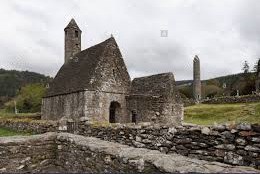
St. Kevin’s Church better known as St. Kevin’s Kitchen is a nave-and-chancel church of the 12th century. Its constructed of hard mica schist. It is the only stone-roofed building to survive at Glendalough.
It is called St Kevin’s Kitchen because people believed that the bell tower was a chimney to a kitchen, but in reality no food was ever cooked there. It's a charming example of an integrated round tower and is one of only two complete engaged towers to survive. The tower stands three stories high. The only access to the belfry was through the croft which in turn was accessed through a small square hole in the vault.The stone roof is unusual, note how it is steeply pitched and corbelled.
Stage 4 Bullaun Stones
At the rear of St Kevin’s Kitchen you will find an example of a Bullaun stone . The Irish word Bullán means ‘bowl’ – a water container. A Bullaun stone is a cup like hole, artificial basins or hollow or depressions in a rock or boulder. There is a lot of debate as to their original use and function.
Local folklore often attaches religious or magical significance to bullaun stones, such as the belief that the rainwater collecting in a stone's hollow has healing properties.
Whereas others think they has a more practical use such as for grinding metal ores or herbs.
Question 4: How wide is the diameter of this Bullaun Stone?
If you think its diameter is approximately 15cm or 6" answer A
If you think its diameter is approximately 25 cm or 10" answer B
If you think its diameter is approximately 35 cm or 14" answer C
If you think its diameter is approximately 45 cm or 18"answer D
Note: There are three bullaun stones in the site, you do not need to take a photograph of this one as part of your log. The one required is at Stage 7.
Stage 5 St.Kevin's High Cross
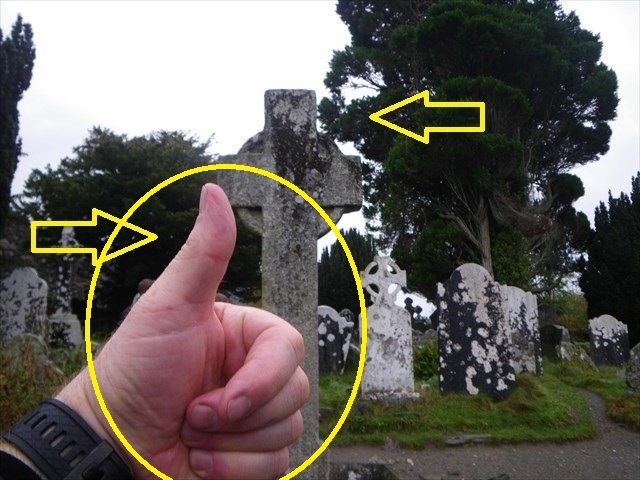
This unmarked High Cross was carved from a single granite stone. The arms of the cross are over a meter in length and it stands 2.5m tall. It may have marked the boundary of the cemetery. It is popularly believed that St. Patrick introduced the Celtic Cross to Ireland, during his conversion of the kings from paganism to Christianity. St Patrick used imagery familiar to the Pagans. like the sun, as pagans already worshiped the sun and the moon.
St. Kevin was as a hermit and the founder of the Monastery. He was thought to have had with an extraordinary and unusual affinity to nature, especially with animals and birds. As a young man he gained a great reputation for performing miracles.
Local legend says that anyone who can wrap their arms around the entire width of the cross body and close the circle by touching fingertips will have their wishes granted. Try your luck, hopefully your wishes will come true!
Take a picture which shows the entire cross with a clearly visible 'thumbs up' sign . (This gesture needs to be in your original photograph and not photoshopped.) The photograph should be taken beside or in front of the cross (no more than 20m away). Please post this picture along with your log. There is no requirement to have your face visible in the picture. This is the first of two photos required to log.
While you are there you might also like to make a wish see if your arms can reach all the way around the cross!
Stage 6 The Priests' House
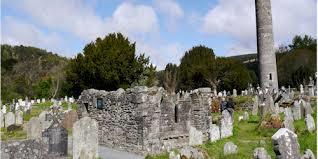
To the west of St Kevin’s Cross lies a small building known as the Priests' house. It is a small rectangular structure, built in the Romanesque style of approx 4.5 x 2.4 meters which probably dates back to the 12th century, around 1170 AD.The Priests’ House has been almost entirely reconstructed from the original stones based on a 1779 sketch.
The original use for this room is uncertain. Conflicting theories suggest that it might have been erected over the grave of St Kevin himself or just housed some relics of the saint. It got its name ‘The Priest House’, after the 18th-19th century practise of local parish priests being buried there. Some say that two priests from the 18th century were renowned for their mystical healing powers making this an important site of pilgrimage for many.
According to local folk tradition, the clay from the floor of a building held a cure for toothache. The clay was simply rubbed on the jaw in order to gain relief.
Question 6:How may vertical grave stones are standing inside the Priest’s House?
Stage 7: Take a photograph giving the 'thumbs up ' sign at The Deer Stone with your thumb and the Round Tower visible in the background.The gesture should be in your original photo.
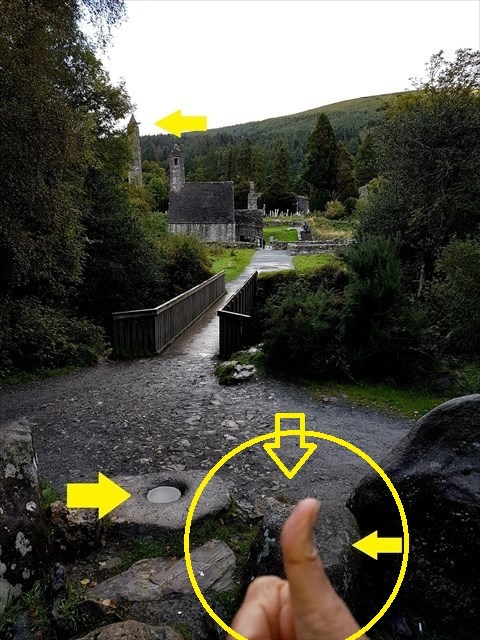
This Bullaun stone derives its name from a legend associated with St. Kevin. Kevin was at heart a hermit and a Christian mystic. One legend holds that the wife of one of the saint’s workmen died giving birth to twins. The workman came to the saint to ask for help in feeding the infants.
Whereas another account claims that the child was the son of a tribal chief. Legend has it that a sorceress named Caineach took revenge on her husband Colman, after her tribal chief husband divorced her and took another wife. (Yes divorce did exist back in ancient Ireland and can be found in our ancient Brehon Laws).
It was claimed that Caineach was responsible for the deaths of all but one of Colman’s children with his second wife. The remaining child Foelan was put into Kevin’s care in the monastery to protect him from Caineach’s vengeance.
Both stories agree that St. Kevin had no milk to feed the infant and he is said to have prayed for guidance. Each morning a Doe came to the monastery and provided milk for the child, which was left in the Bullaun stone at the entrance to the monastery. Hence the name ‘Deer Stone’.
It is important to remember that the stories about St Kevin’s life were handed on firstly by oral tradition, only to be written down five hundred years after his death, so should not be taken too historically or interpreted in a literal way.
Take a photo at this spot giving a clearly visible "thumbs up" in your picture.You are not required to show your face in the picture if you do not wish to - but it needs your thumb.
In order to claim a find your thumb, the Round Tower and the Deer Stone should be visible in the photograph (please refer to the picture on the cache description if you need to).
When logging please upload your two photographs along with your log.
PLEASE USE A "WRITE NOTE" IF YOU ARE NOT IN A POSITION TO UPLOAD PHOTOGRAPHS WITH YOUR LOG
PLEASE NOTE: LOGS THAT DO NOT HAVE BOTH PHOTOS , or LOGS THAT SHOW A DIFFERENT SCENE WILL BE DELETED WITHOUT COMMENT. THE PHOTOGRAPHS MUST HAVE THE 'THUMBS UP' IN THE SHOT. From October 1st 2018 photoshopped thumbs added to photos are not acceptable. In regards to GROUP logs, a group photo is permitted but all in the group must make the THUMBS UP SIGN. THE GROUP PHOTO SHOULD BE UPLOADED TO THE LOG OF EACH FINDER.

The photography is a mandatory requirement.
IN SUMMARY:
To claim a find please upload two 'thumbs up' photos with your log
One at the Deer Stone with the Round Tower in the distance and the other at St. Kevin's High Cross
AND email me or contact me via the messaging center with the answers to the following five questions:
1.The number of holes can you see on the inner archway of the gateway?
2. The two animals found on the replica cross beside the Round Tower?
3. The number of leaves on the gravestone in the Cathedral?
4.The approximate width/diameter of the Bullaun Stone?
5.The number of vertical grave stones standing inside the Priests' House?
Go ahead and log once you have uploaded both photographs which must show a thumbs up.

I will be in touch if the questions are answered partially or incorrectly.
I hope you enjoyed your visit to this stunning location and learned a little about this Monastic site, its myths, legends and lore.
Wishing you every success in finding everything you seek.
Wa Wa
If you do not access to the internet to upload your photos please use a "Write Note" instead of a "Found it" log. Found logs without pictures or information promising a later upload will be deleted. Please only log a find when you have submitted the relevant information.
Please note **** If you visited Glendalough prior to publication of this cache and have photos from the site that do not match the logging requirements then you cannot claim a find. Emails requesting permission to log without the correct photos and information will not be replied to.****
Parking There is no charge to visit the Monastic Site, however car parking charges apply.
The Visitor Centre (OPW) carpark
Charges apply at weekends (Saturday, Sunday and Bank Holiday Mondays) during April to September only (this maybe subject to change). The charge is €4 per car, €25 per bus and €15 for minibuses and camper vans. This charge will be refundable to Visitors wishing to visit the Visitor Centre.
Upper Car Park
The Upper Lake car park in Glendalough is owned by Wicklow County Council and its management is franchised out. There is also a charge of €4 per car in the Upper Lake car park.
Getting there on Public transport
A private bus service leaves Dawson Street just near St. Stephens Green daily at 11:30am, and collects you again from the Glendalough visitor centre at 6:00pm.
There is no direct public bus service to Glendalough but you can take the bus from Dublin/Wexford as far as Rathdrum (the nearest stop to Glendalough) and then take a taxi from Rathdrum to Glendalough.
Virtual Reward - 2017/2018
This Virtual Cache is part of a limited release of Virtuals created between August 24, 2017 and August 24, 2018. Only 4,000 cache owners were given the opportunity to hide a Virtual Cache. Learn more about Virtual Rewards on the Geocaching Blog.